
A Four-Country Study
After decades of mobilization and advocacy, how familiar are ordinary people with human rights, and how is this familiarity shaped by socio-economic status? We explore these questions with new data from the Human Rights Perception Polls, representative surveys conducted in four countries. We find that public exposure to the term “human rights” is high in Colombia, Mexico and parts of Morocco, but more moderate in and around Mumbai, India. The public’s rate of personal contact with rights activists, workers and volunteers, however, is much more limited. For both indicators, moreover, socio-economic status is a meaningful statistical predictor. People who are more educated, wealthier, reside in urban areas and enjoy Internet access also tend to be more familiar with the term “human rights,” and to have met a human rights worker, activist, or volunteer. These findings should concern human rights strategists keen to promote ties with the poor. To address this challenge, human rights groups should develop more popularly oriented models of engagement and resource mobilization.
Although there are no formal mechanisms linking human rights actors with specific constituencies, many rights-based actors believe they represent the interests, needs and aspirations of society’s most disempowered and vulnerable. Up until now, however, these beliefs have been unsupported by much systematic evidence. For reasons of cost, inclination and feasibility, human rights researchers rarely ask ordinary people for their views on—and experience with—human rights language and organizations. This article addresses this knowledge gap with original public surveys in four countries. We asked thousands of people how much they had heard the term “human rights,” and whether they had ever met a self-identified human rights worker, activist, or volunteer. Armed with this data and aided by statistical analysis, we investigate the prevalence and correlates of public human rights familiarity.
We find that familiarity with human rights terms and representatives increases with socio-economic status. This finding is of concern, we believe, because familiarity with human rights is an indicator of the movement’s representational success. Human rights organizations cannot persuasively claim to represent ordinary people if those individuals have neither heard their message, nor met their representatives. Rights groups cannot credibly claim to represent society’s poorest sectors, moreover, if public outreach in these communities is systematically and meaningfully undermined by low socioeconomic status.
We conducted our Human Rights Perceptions Polls in 2012 in Colombia, India, Mexico and Morocco. We selected these countries for their diversity across multiple indicators, including distinct world regions (Latin America, North Africa and South Asia), colonial histories (Spain, France and Britain), world religions (Christianity, Islam and Hinduism) and linguistic traditions (Spanish, Arabic, French and Hindi). This diversity boosts the generalizability of our findings.
Conducting public surveys in these four countries also makes sense because, in each, significant numbers are exposed to human rights terminology and workers. Although all four countries have serious human rights problems, they all enjoy a modicum of political and civil liberties, including some freedom of speech, movement and association. Most importantly, each country has an active civil society and a vibrant domestic human rights sector.
Human rights discourse is ubiquitous in global media, diplomatic and policy circles (MOYN 2010; RON; RAMOS; RODGERS, 2005), provoking comparisons with other transnational lingua franca, such as mathematics or statistics (CMIEL, 2004). Important questions remain, however, about the ability of human rights terms and activists to break out of elite circles and penetrate mass publics (HAFNER-BURTON; RON, 2009). Many worry that human rights, like other transnational and cosmopolitan ideas, are little more than the “class consciousness of frequent travelers,” destined to languish forever among the upper global crust (CALHOUN, 2002).
These concerns are intimately connected to questions of political representation. Which communities, and interests, do human rights organizations speak for? Whom do they really represent? The most “wretched of the earth” (FANON, 2005), as many hope, or the global middle class, as many fear? Public familiarity with human rights is not the only indicator of representation, of course, but it is important. No self-respecting Communist would ever have laid claim to representing the working class if laborers had never met Party members, and no self-respecting evangelist would claim success amidst popular ignorance of Christ or Muhammad. Familiarity both with the Word and its Messenger may not be sufficient for representation, but does seem rather necessary.
What, then, did we expect to find? On the one hand, the poorest and most disempowered are often likely to suffer most from all manner of human rights violations (KHAN; PETRASEK, 2009). As a result, they should, in theory, have the most incentive to acquire human rights knowledge and contacts. Human rights activists, for their part, should be keenly motivated to reach out to this demographic. As many advocates argue, the human rights movement’s most pressing task is to work with and alongside the poor, often through the rights-based approach to development. If true, then people situated at the lowest rung of society’s socioeconomic ladder should have more human rights familiarity than those located higher up.
Yet many observers would predict the precise opposite (AN-NA’IM, 2000; ENGLUND, 2006; HOPGOOD, 2013; ODINKALU, 1999; OKAFOR, 2006). The human rights movement’s stated aspirations aside, wealthier and better-educated people always have more access to resources and information and often find greater value in abstract, cosmopolitan ideas such as human rights. Historically, moreover, it was often the urban, middle or organized working classes who expressed the most interest in individual rights, rather than the disorganized, under-educated or rural poor (HUBER; RUESCHEMEYER; STEPHENS, 1993; LIPSET, 1959; MAMDANI, 1996). Although human rights activists may hope the poor are more familiar with their work, some experts would argue that sociological and political realities suggest otherwise.
Happily, these different expectations can be adjudicated with the help of well-designed, statistically representative public surveys.
In the publication, we describe our Human Rights Perception Polls (RON; CROW, forthcoming). Briefly, we gathered our Mexican and Colombian data in collaboration with the Americas and the World survey team at the Center for Economic Research and Teaching (CIDE) in Mexico City.1 We collected our Moroccan and Indian data in collaboration with local survey companies.
Mexico: Our Mexican data includes a nationally representative sample of 2400 adults aged 18 and over, along with a smaller sample of 500 persons drawn from Mexico’s “power elite” (MILLS, 2000), including business executives, elected officials, high-ranking bureaucrats, journalists and academics. This second poll of elites is illustrative, not statistically representative.
Mexico is a good case for investigating popular human rights familiarity. Systematic rights violations abound, but Mexico’s growing democracy and socio-demographic profile afford opportunities for human rights debate and citizen involvement. Mexico’s population is wealthier, better educated and more exposed to global ideas than many, its press and political system are relatively free and its population has strong ties to a U.S.-based diaspora. The country has had a vibrant domestic rights sector since the early 1990s and the government’s policy rhetoric is favorable to human rights concerns (ANAYA MUÑOZ, 2009). Human rights are intensely topical, moreover, because of the country’s brutal internal drug war (INTERNATIONAL CRISIS GROUP, 2013). Criminals and security forces have killed over 70,000 and disappeared thousands more since 2006.
Colombia: Our Colombian data also includes a nationally representative sample of 1,700 adults. Like Mexico, Colombia is a strong case for investigating public human rights familiarity. Decades-old violence between security forces, leftist guerrillas and state-sponsored paramilitary groups—all variously tied to drug cartels—has generated multiple rights violations. The government frames the country’s conflict as a war on terrorism, and many Colombians regard the government’s security policies as effective. But these policies have also exacted a high civilian toll, including 30-50,000 forced disappearances and a series of “parapolitics” scandals linking politicians and military officers to right-wing paramilitaries (HUMAN RIGHTS WATCH, 2012). Like Mexico, Colombia has an active domestic human rights community comprising many hundreds of groups organized in dense networks, along with strong transnational ties (BRYSK, 2009; OIDHACO, 2013).
Morocco: Our Moroccan data includes a sample of 1,100 adults and is representative of the population residing in Rabat and Casablanca, the country’s adjacent political and financial capitals, and of rural residents living up to 70 kilometers from either city. Morocco also offers fertile ground for investigating rights familiarity (RON; GOLDEN, 2013). The country’s worst violations of civil and political rights occurred during the 1970s and 1980s, known as the “Years of Lead.” Morocco began liberalizing in the 1990s, included human rights commitments in a new constitution and accelerated the liberalization process under a new king in the 2000s. Gender-based rights activists have made particular progress. Although restrictions and abuses continue against Islamist and Western Sahara activists, the domestic Moroccan rights sector is vocal, self confident and comparatively effective (SLYOMOVICS, 2005).
India: Our Indian data includes a sample of 1,600 adults and is representative of residents of Mumbai, the country’s cultural and financial capital, and the adjoining rural areas of Maharashtra State.
India’s population is similar to Morocco’s in terms of income and education and poorer and less literate than Mexico’s or Colombia’s. India has the longest democratic tradition of all four, however, as well as a cacophonous domestic press and long history of rights-based activism, including path-breaking legal advances in social and economic rights (GUDAVARTHY, 2008; JHA, 2003; RAY, 2003). These include the 2005 Right to Information Act, the 2009 Right to Education Act and the 2013 National Food Security Act. Mumbai is home to India’s first civil liberties groups and is a center for local efforts to protect the rights of women and slum dwellers, improve communal relations and advocate for housing and food security rights.
We use two variables to measure the public’s familiarity with human rights. To assess respondents’ exposure to human rights terminology, we ask, “In your daily life, how often do you hear the term ‘human rights’?” [Daily; Frequently; Sometimes; Rarely; Never]. To assess respondents’ personal contact with human rights workers/volunteers, we asked, “Have you ever met someone who works in a human rights organization?” [Yes; No].
We measure respondents’ socioeconomic status by assessing their education, place of residence, income and Internet access. For education, we asked, “What is the highest level of education you have completed?”2 For urban residence, we coded the area where respondents lived with accepted Moroccan census classifications. For income, we used a subjective perception of income relative to expenditures, asking, “With total family income, which statement best describes your income status?” [“My income allows me to cover expenses and save”; “My income can just cover expenses, without major difficulties”; “My income cannot cover expenses, and I have difficulties”; “My income cannot cover expenses and I have major difficulties”].3 For Internet use, we asked, “Do you use the Internet?” [Yes; No]. We also include two control variables, sex and age [in years].
We begin with the Mexican case, as it is the only one of our four cases with both a public and an elite sample.
Figure 1 demonstrates that the prevalence of human rights terminology among both Mexican elites and general public is high, but that elite exposure is much higher. Some 90 percent of elite Mexicans told us they heard “human rights” (derechos humanos) either “daily” or “frequently,” compared to almost 40 percent among the general public. Yet even this figure of 40 percent seems extraordinarily large; extrapolating, it suggests that some 30 million Mexican adults are exposed to the words derechos humanos on a daily basis.
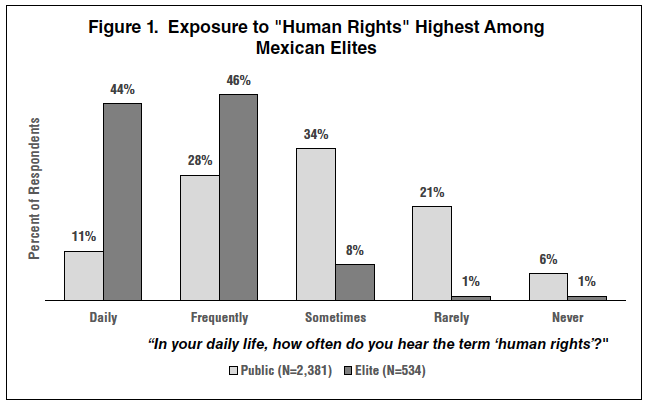
Remarkably, human rights exposure in Colombia and Morocco is even higher. As Figure 2 notes, 49 percent of Colombian adults say they routinely hear the term derechos humanos while 54 percent of adults living in and around Rabat and Casablanca reported regularly hearing the French, droits de l’homme or the Arabic hukuk al insaan. And while our Indian survey reveals lower rates of public exposure—only 20 percent of adults living in and around Mumbai reported regularly hearing either the Hindi manava adhikara or the Marathi manavi adhikara—even this comparatively low exposure rate seems high.
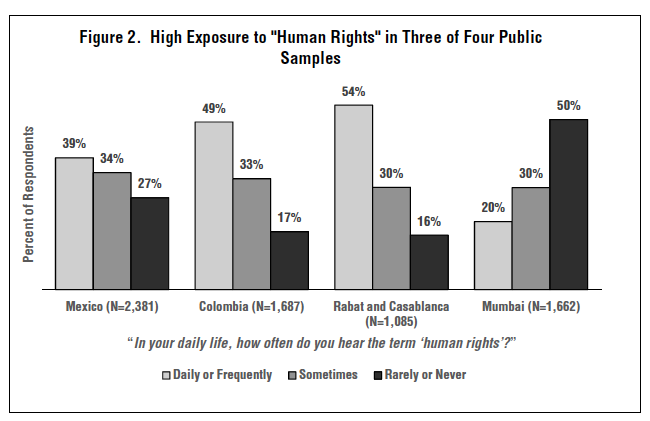
Personal contact with human rights workers, unsurprisingly, was much lower. In Mexico, moreover, our separate elite and mass samples were very different. As Figure 3 notes, 86 percent of Mexican elites report having met someone active with a human rights organization, compared to only 11 percent among the general public. Mexican human rights activists circulate far more frequently and intensively in their society’s upper realms.
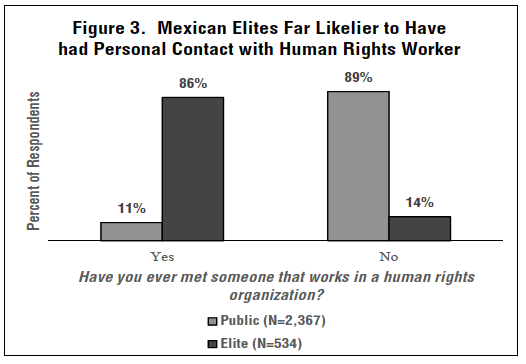
Yet here, too, the Mexican and Colombian glass is half full, since 11 and 18 percent of their general population has met a human rights worker. In Mexico, this would suggest an overall figure of eight million (see Figure 4). These high rates likely stem from the two countries’ drug-related internal conflicts, population displacements, government rhetoric and strong activist outreach.
In Morocco and India, by contrast, the public’s contact with human rights personnel is far lower. Only 7 percent of adults living in and around Rabat and Casablanca report having met a human rights worker, while in Mumbai and its rural environs, only one percent have.
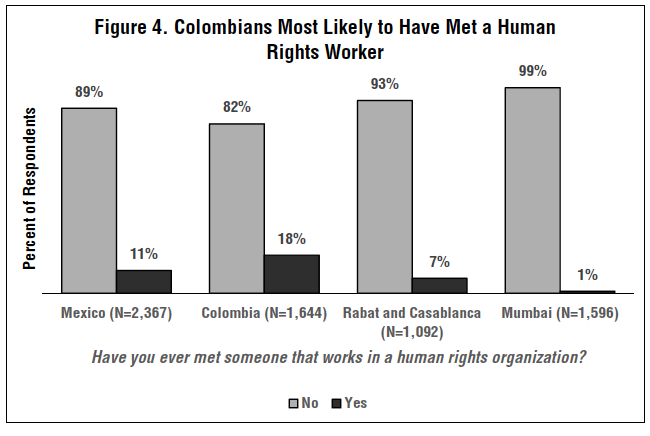
Our methodology allows us to assess the link between socio-economic factors and the public’s human rights familiarity. We find that in all four countries, higher socioeconomic status (SES) is correlated with more exposure to human rights terms and workers. Table 1 presents an overview of our findings. A plus sign (+) signifies a positive and statistically significant relationship between one of our four SES variables (education, urban residence, income and Internet use) and our two measures of human rights familiarity, namely: respondents’ exposure to human rights terminology, and respondents’ personal contact with human rights workers/activists/volunteers; a minus sign (-) signifies a negative relationship between SES and familiarity; and “n.f.,” or “no finding,” signifies no statistically significant relationship.
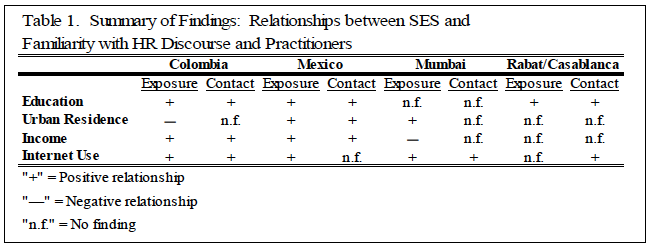
In all countries, some SES measures are meaningfully associated with greater human rights familiarity and in some countries, all four measures are associated with greater human rights familiarity. Education and Internet use were the leading correlates, as they enjoyed positive statistical associations with the public’s human rights familiarity in six of eight possible cases. Income was next, with a positive association in four of eight cases, while urban residence had a positive association in three. Cumulatively, these findings suggest that higher social standing is reliably associated with human rights familiarity in all four countries.
Table 2 contains our full regression results. Since the dependent variable respondent exposure is ordinal – that is, arranged in a well-ordered set–we modeled its effects with ordinal logistic regression, a commonly used statistical technique that estimates the net effects of various independent factors, or variables, on a single, ordered, “outcome” factor, or variable. In these models, the coefficients should be interpreted as the strength of the effect an independent variable has on the odds of belonging to “higher” categories (e.g., hearing human rights “daily” or “frequently”), as opposed to the odds of belonging to “lower” categories (e.g., hearing human rights only “sometimes,” “rarely” or “never”). And since the dependent (or outcome) variable respondent personal contact is a dichotomous, or “yes/no” response, we used simple binary logistic regression. Here, coefficients should be interpreted as the effect of an independent variable on the odds of a respondent’s having ever met a human rights worker.
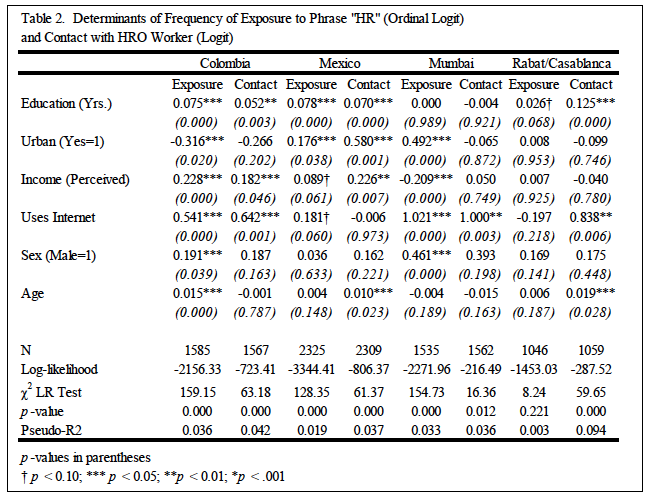
Better-educated respondents hear the phrase “human rights” far more frequently and are likelier to have met a human rights worker than their less-educated counterparts in Colombia, Mexico, and Rabat/Casablanca (see Figure 5).
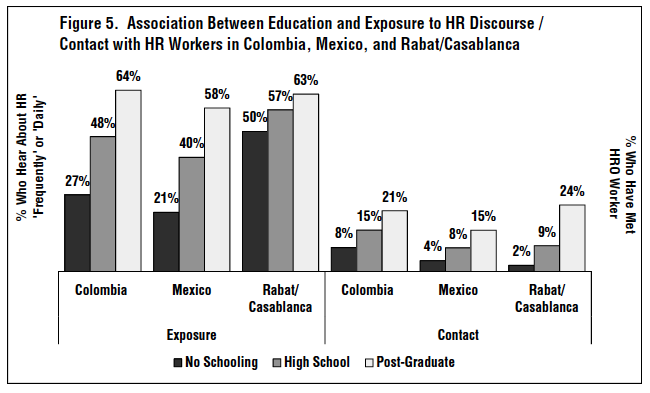
To gauge the impact of education on respondent exposure to the words “human rights,” we combined the two highest responses, “frequently” and “daily.” The association between education and exposure is strongest in Colombia (shown by the three leftmost bars above the “Exposure” category label) and Mexico (the three middle bars in “Exposure”). Some 64 percent of Colombians with a doctorate or equivalent degree (21 years of education, white bars) hear often about derechos humanos, compared to only 48% of Colombians who have completed high school (light gray bars) and 27 percent with no formal education (dark gray bars). The same is true for Mexico, where about 58 percent of respondents with 21 years of schooling hear about human rights often, compared to only 40 percent who have completed high school and 21 percent with no schooling. The association with education is not as pronounced in Morocco (the three rightmost bars in “Exposure”), because a high proportion of Moroccans with no education (50 percent) already hear frequently about human rights.
The three sets of bars to the right of Figure 5, above the “Contact” category label, track education’s association with the probability of respondent contact with a human rights worker. The link is most pronounced in Rabat/Casablanca (the three rightmost bars), where going from the minimum to the maximum of the education range is associated with an increase in the probability of respondent contact with a human rights worker from two to 24 percent. The association is more modest, but still important, for Colombia (the three leftmost bars in “Contact,” rising from eight percent to about 21 percent) and Mexico (the three middle bars in “Contact,” which increase from four percent to about 15 percent).
Figure 6 depicts the estimated probabilities of respondent exposure and contact for Internet users (dark gray bars) and non-Internet users (light gray). The positive association with respondent exposure is strongest in Mumbai, where 27 percent of Internet users hear about human rights often, compared to only 12 percent of non-Internet users. In Colombia, 59 percent of Internet users are often exposed to human rights discourse, compared to 45 percent of non-Internet users. The difference in Mexico is smaller but still statistically significant, at 39 versus 35 percent.
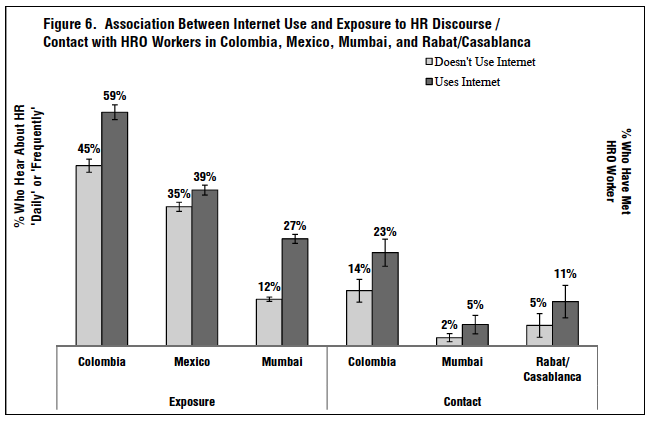
The data evince a similarly positive association between Internet use and respondent contact with human rights workers. In Colombia, the odds of a respondent having had personal contact with a human rights worker increase with Internet use from 14 to 23 percent, while in Rabat/Casablanca and Mumbai, it more than doubles.
Figure 7 depicts the association of respondent exposure and respondent contact with income. We assess the size of these effects by comparing those at the maximum and minimum of our perceived income scale. In Colombia, those who “cannot cover expenses” and have “major economic difficulties” (the dark gray bars) have about a 37 percent chance of hearing about human rights often (the leftmost, dark gray bar above the “Exposure” category label) and a 11 percent chance of having met a human rights worker (the leftmost, dark gray bar above the “Contact” category label)). These figures rise to 53 percent and 17 percent, respectively, for Colombians whose income allows them “to cover expenses and save” (light gray bars immediately to the right of the dark gray bars for “cannot cover expenses/major difficulties”).
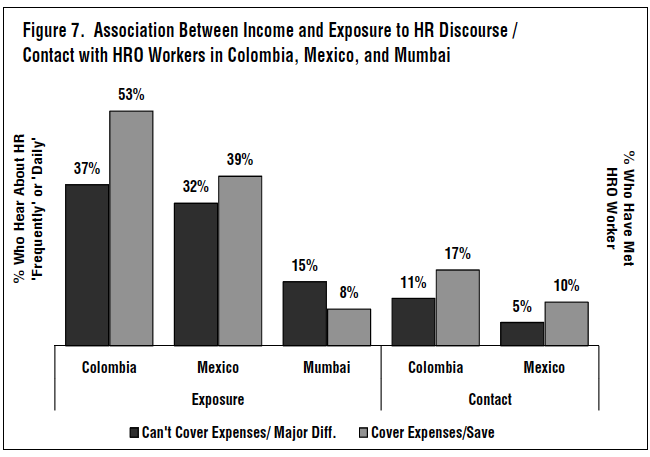
In Mexico, these same associations are statistically significant, albeit less dramatically so. Poorer Mexicans have a respondent exposure rate to human rights of 32 percent (the second dark gray bar from left to right), as well as a 5 percent personal contact rate (the rightmost dark gray bar). Their wealthier counterparts, by contrast, have higher exposure and personal contact rates (39 and 10 percent, respectively, as shown by the second light gray bar from left to right and the rightmost light gray bar).
In Mumbai, however, exposure to the phrase “human rights” decreased with income (two bars above the “Mumbai” category label). The data suggest that wealthy people living in and around Mumbai hear human rights “often” about seven percentage points less than the poor. Intriguingly, human rights workers and messages circulate more heavily among the poor in this part of India. Although this individual finding does not undermine our overall argument, it does suggest that something rather different is going on in that context.
Finally, city residence tends, overall, to be associated with greater respondent exposure and contact. Urban residents in Mexico, for example, are more likely to hear about human rights often (39 percent) and to have met a human rights worker (12 percent) than their rural counterparts (35 and 7 percent, respectively). Similarly, city-dwelling Mumbaikars have higher rates of respondent exposure (18 percent) than rural Marathis (12 percent).
Once again, however, there are some puzzling differences. In Colombia, for example, rural Colombians have more respondent exposure than urbanites (45 to 38 percent) and the explanation may be linked to Colombia’s war on drugs, counterinsurgency campaigns and attendant rights violations, much of which occurred in rural zones. Once again, this counter-intuitive finding reminds us that careful, country-specific data collection is vital.
These two exceptions notwithstanding, the positive relationship between socioeconomic status and human rights familiarity is a strong general finding, robust to different measurements of familiarity (as respondent exposure and respondent personal contact) and socioeconomic status (education, income, Internet use and urban residence).
Our two control variables, age and sex, are also statistically significant, in some instances. Men are more likely than women to frequently hear the phrase, human rights, in Colombia and Mumbai (see Table 2), while rates of personal contact with human rights workers increase with age in Mexico and Morocco. Respondent exposure, moreover, increases with age in Colombia.
Our Human Rights Perception Polls show that ordinary people across regions, linguistic divides, religions and colonial traditions often hear the phrase “human rights.” Personal contact with human rights activists, however, is much less frequent. The data also show that both the human rights Word and its Messengers circulate more heavily among wealthier, better educated and more Internet-savvy respondents. Although this finding may disappoint human rights activists keen to stand in solidarity with the poor, it should not surprise. After all, many observers have long suspected as much, although none, until now, have provided systematic evidence.
There is no reason to suspect that higher human rights familiarity guarantees good deeds or intentions, of course. Although our study shows that elites are more exposed to human rights terms and activists than the poor, elites are also the source of many persistent human rights problems. Our study does not claim that human rights familiarity changes behavior for the better. The more important issue, in our view, is that of representation. If familiarity with human rights terms and activists declines with socio-economic status, human rights organizations’ claim to represent the poor and disempowered is dramatically weakened. One cannot claim to “represent” people whom one has never met, or who only rarely hear one’s message.
Must human rights groups seek to represent the poor? The question cuts to the heart of many long-standing debates. Some view the human rights movement as appropriately elite-oriented, arguing that rights groups’ chief mission is, and should be, supporting high level reform, often of a technical, policy or legalistic nature (GONZÁLEZ, 2013). If true, comparatively low human rights familiarity among those from lower socio-economic backgrounds offers little cause for concern; it is elites who are the true target audience. Still others suggest that human rights groups’ chief contribution is serving as connectors between grassroots communities, activists and elites (ANSOLABEHERE, 2013; GALLAGHER, 2013). Human rights activity, in this view, is not a popularity contest but rather a back-stage networking effort that promotes the concerns of marginalized groups from a distance.
For many others, however, the proper role of human rights groups should be to represent and stand in solidarity with the poor. This, for example, is the view of those who write about the “rights-based approach to development,” an approach that has gained much policy traction of late (KINDORNAY; RON; CARPENTER, 2012). It is also popular among those concerned with promoting human rights as a form of mass-based activism, rather than a professional practice of policy and legal advocacy (BANYA, 2013; BROWNE; DONNELLY, 2013; ZIV, 2013). Analysts and activists of this sort will be concerned by our results, and perhaps use them to press rights groups to make more and better contact with poorer and broader populations.
It is possible, of course, for human rights groups to play both roles, working both with elites and with people from more modest socio-economic backgrounds (AZZAM, 2014). Still, if they want their claims of representation to have legitimacy, human rights activists must expand their reach and engage more seriously, widely and genuinely with ordinary people. These outreach efforts must guard against the condescending, foreign-funded and top-down approaches described so alarmingly by critical anthropologists such as Harry Englund (ENGLUND, 2006). Outreach with the poor cannot be reduced to a development-style log-frame, in which useless visits to rural communities and poor neighborhoods are ticked off on spreadsheets to satisfy donors.
To ensure their engagement with ordinary people is positive and genuine, human rights groups must recruit more volunteers and dues-paying members and enhance their ability to mobilize resources among individuals and communities of modest means (ASHRAF 2014; SURESH 2014). Greater human rights representation and familiarity among the poor will be enhanced by a more popularly-oriented approach to resource mobilization (RON; PANDYA, 2013).
1. The Americas and the World survey reports and data are available freely online at: http://lasamericasyelmundo.cide.edu. Last accessed on: 21 July 2014.
2. We adapted this question to the peculiarities of each country’s system.
3. We have traditional monetary income measures, but these are prone to error.
Bibliography and other sources
AN-NA’IM, Abdullahi. 2000. Problems of Dependency: Human Rights Organizations in the Arab World, An Interview with Abdullahi An-Na’im. Middle East Report, Washington, DC, v. 214, p. 20-47, Sept.
ANAYA MUÑOZ, Alejandro. 2009. Transnational and Domestic Processes in the Definition of Human Rights Policies in Mexico. Human Rights Quarterly, Baltimore, v. 31, n. 1, p. 35-58, Feb.
ANSOLABEHERE, Karina. 2013. Reforming and transforming: a multi-directional investigation of human rights. openDemocracy, openGlobalRights [online], 4 Dec. Available at: http://www.opendemocracy.net/openglobalrights/karina-ansolabehere/reforming-and-transforming-multi-directional-investigation-of-h. Last accessed on: 7 Mar. 2014.
ASHRAF, Ajaz. 2014. To raise funds, Indian rights groups must emulate the country’s newest political party. openDemocracy, openGlobalRights [online], 28 Jan. Available at: http://www.opendemocracy.net/openglobalrights/ajaz-ashraf/to-raise-funds-indian-rights-groups-must-emulate-country’s-newest-polit. Last accessed on: 4 Apr. 2014.
AZZAM, Fateh. 2014. In defense of “professional” human rights organizations. openDemocracy, openGlobalRights [online], 13 Jan. Available at: http://www.opendemocracy.net/openglobalrights/fateh-azzam/in-defense-of-professional-human-rights-organizations. Last accessed on: 4 Apr. 2014.
BANYA, Moiyattu. 2013. Human Rights for Whom? A Closer Look at Elitism and Women’s Rights in Africa. openDemocracy, openGlobalRights [online], 17 Jan. Available at: https://www.opendemocracy.net/openglobalrights/moiyattu-banya/human-rights-for-whom-closer-look-at-elitism-and-women’s-rights-in-a. Last accessed on: July 22, 2014.
BROWNE, Nicola; DONNELLY, Dessie. 2013. Making Human Rights Matter to the Marginalised. openDemocracy, openGlobalRights [online], 17 Jan. Available at: https://www.opendemocracy.net/openglobalrights/nicola-browne-dessie-donnelly/making-human-rights-matter-to-marginalised. Last accessed on: July 22, 2014.
BRYSK, Alison. 2009. Communicative action and human rights in Colombia: When words fail. Colombia Internacional, Bogotá, v. 69, p. 36-49, Jan./Jun.
CALHOUN, Craig. 2002. The Class Consciousness of Frequent Travelers: Toward a Critique of Actually Existing Cosmopolitanism. South Atlantic Quarterly. Vol. 101, p.871-897.
CMIEL, Kenneth. 2004. The Recent History of Human Rights. American Historical Review. Vol. 109, p. 117-135.
ENGLUND, Harri. 2006. Prisoners of Freedom: Human Rights and the African Poor. Berkeley, CA: University of California Press.
FANON, Franz. 2005. The Wretched of the Earth. Grove Press.
GALLAGHER, Janice. 2013. Neither elites nor masses: protecting human rights in the real world. openDemocracy, openGlobalRights [online], 17 Dec. Available at: http://www.opendemocracy.net/openglobalrights/janice-gallagher/neither-elites-nor-masses-protecting-human-rights-in-real-world. Last accessed on: 7 Mar. 2014.
GUDAVARTHY, Ajay. 2008. Human Rights Movements in India: State, Civil Society and Beyond. Contributions to Indian Sociology, Thousand Oaks, v. 42, n. 1, p. 29-57, Apr.
HAFNER-BURTON, Emilie.; RON, James. 2009. Seeing Double: Human Rights Impact through Qualitative and Quantitative Eyes. World Politics. Princeton, NJ, v. 61, p. 360-401.
HOPGOOD, Stephen. 2013. The Endtimes of Human Rights. Ithaca: Cornell University Press.
HUBER, Evelyne; RUESCHEMEYER, Dietrich; STEPHENS, John D. 1993. The Impact of Economic Development on Democracy. Journal of Economic Perspectives, Nashville, TN, v. 7, n. 3, p. 71-85, Summer.
HUMAN RIGHTS WATCH. 2012. World Report 2012: Colombia. New York. Available at: http://www.hrw.org/world-report-2012/colombia. Last accessed on: 7 Mar 2014.
INTERNATIONAL CRISIS GROUP. 2013. Peña Nieto’s Challenge: Criminal Cartels and Rule of Law in Mexico. Latin America Report, Brussels, n. 48, 19 Mar. Available at: http://www.crisisgroup.org/~/media/Files/latin-america/mexico/048-pena-nietos-challenge-criminal-cartels-and-rule-of-law-in-mexico.pdf. Last accessed on: 7 Mar 2014.
JHA, Munmun. 2003. Nehru and Civil Liberties in India. International Journal of Human Rights, London, v. 7, n. 3, p. 103-115, Oct.
KHAN, Irene; PETRASEK, David. 2009. The Unheard Truth: Poverty and Human Rights. New York: W.W. Norton & Co.
KINDORNAY, S.; RON, J.; CARPENTER, R.C. 2012. The Rights-Based Approach to Development: Implications for NGOs. Human Rights Quarterly, Baltimore, v. 34, n. 2, p. 472-506, May.
LIPSET, Seymour M. 1959. Some Social Requisites of Democracy: Economic Development and Political Legitimacy. American Political Science Review, Washington, DC, v. 53, n. 1, p. 69-105, Mar.
MAMDANI, Mahmood. 1996. Citizen and Subject: Contemporary Africa and the Legacy of Late Colonialism. Princeton, NJ: Princeton University Press.
MILLS, Charles W. 2000. The Power Elite. New York: Oxford University Press.
MOYN, Samuel. 2010. The Last Utopia: Human Rights in History. Cambridge, MA: Belknap Press.
MUTUA, Makau. 1996. The Ideology of Human Rights. Virginia Journal of International Law, Charlottesville, VA, v. 36, p. 589-657.
______. 2001. Savages, Victims and Saviors: The Metaphor of Human Rights. Harvard International Law Journal, Cambridge, MA, v. 42, p. 201-245.
GONZÁLEZ O., Ezequiel. 2013. Speaking with an elite accent: human rights and the “masses.” openDemocracy, openGlobalRights [online], 20 Nov. Available at: http://www.opendemocracy.net/openglobalrights/ezequiel-gonzález-ocantos/speaking-with-elite-accent-human-rights-and-masses. Last accessed on: 7 Mar. 2014.
ODINKALU, Chidi A. 1999. Why More Africans Don’t Use Human Rights Language. Carnegie Council, Human Rights Dialogue, v. 2, n. 1, 5 Dec. Available at: http://www.carnegiecouncil.org/publications/archive/dialogue/2_01/articles/602.html. Last accessed on: 7 Mar 2014.
OIDHACO. 2013. International Office for Human Rights Action on Colombia. Associated Platforms in Colombia. Bruselas, Bélgica, Website. Available at: http://www.oidhaco.org/?cat=1006&lang=en. Last accessed on: 7 Mar 2014.
OKAFOR, Obionara C. 2006. Legitimizing Human Rights NGOs: Lessons from Nigeria. Trenton, NJ: Africa World Press.
RAY, Aswini K. 2003. Human Rights Movement in India: A Historical Perspective. Economic and Political Weekly, Mumbai, v. 38, n. 32, p. 3409-3415, Aug.
ROBINSON, Mary. 2005. What rights can add to good development practice. In: ALSTON, Philip;
ROBINSON, Mary. (Org.). Human Rights and Development: Towards Mutual Reinforcement. New York: Oxford University Press. p. 25-44.
RON, James; CROW, David. forthcoming. Who Trusts Local Human Rights Organizations? Evidence from Three World Regions. Human Rights Quarterly, Baltimore, 10 Mar.
RON, James; GOLDEN, Shannon. 2013. Growing Local Roots? The Human Rights Sector in Morocco. Minneapolis, University Minnesota, Oct. Available at: http://jamesron.com/documents/FinalMoroccoReport.pdf. Last accessed on: 7 Mar 2014.
RON, James; PANDYA, Archana. 2013. Universal values, foreign money: local human rights organizations in the Global South. openDemocracy, openGlobalRights [online], 13 Nov. Available at: http://www.opendemocracy.net/openglobalrights/james-ron-archana-pandya/universal-values-foreign-money-local-human-rights-organiza. Last accessed on: 4 Apr. 2014.
RON, James; RAMOS, Howard; RODGERS, Kathleen. Transnational Information Politics: NGO Human Rights Reporting, 1986-2000. International Studies Quarterly. Vol. 49, p.557-588.
SLYOMOVICS, Susan. 2005. The Performance of Human Rights in Morocco. Philadelphia: University of Pennsylvania Press.
SURESH, V. 2014. Funds and civil liberties. openDemocracy, openGlobalRights [online], 6 Jan. Available at: http://www.opendemocracy.net/openglobalrights/v-suresh/funds-and-civil-liberties. Last accessed on: 4 Apr. 2014.
WORLD PUBLIC OPINION. 2008. World Public Opinion and the Universal Declaration of Human Rights. Washington, DC: Global Public Opinion on International Affairs, worldpublicopinion.org. Available at: http://www.worldpublicopinion.org/pipa/pdf/dec08/WPO_UDHR_Dec08_rpt.pdf. Last accessed on: 7 Mar 2014.
ZIV, Hadas. 2013. “Human Rights” must join activists in social struggle. openDemocracy, openGlobalRights [online], 11 Jul. Available at: http://www.opendemocracy.net/openglobalrights/hadas-ziv/%E2%80%98human-rights%E2%80%99-must-join-activists-in-social-struggle. Last accessed on: 7 Mar. 2014.